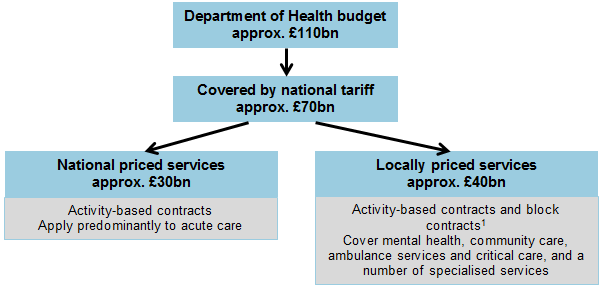This blog post introduces the national tariff, its aims and Monitor’s role in setting it.
It's part of a series of blog posts that we're writing in the run-up to the publication of Monitor and NHS England’s national tariff proposals for the 2015/16 financial year.
Why do we have a national tariff for healthcare?
The national tariff is the mechanism by which the total amount of money the government allocates to the NHS in England is translated into healthcare for millions of individual patients every year.
The NHS is, of course, free at the point of delivery (the point at which patients access or use the services), but hospitals and other providers of care still need to get paid for the services they deliver.
The care required by local communities is bought by Clinical Commissioning Groups who will prioritise their budgets to best meet these local needs.
The national tariff is the basis on which NHS care is paid for. It aims to be a basis that promotes the most efficient and sustainable delivery of care to patients. The tariff consists of:
- national prices for a set of healthcare services
- principles for how these national prices can be varied to promote innovations in service and to reflect local conditions
- rules and principles for agreeing locally how and how much to pay for healthcare services that do not have a national price
How the NHS budget is split across different parts of the national tariff

Making the best use of NHS resources
The power of the national tariff to benefit patients lies in the way prices and payment approaches can influence the care which is provided to patients.
Prices based on accurate information on the cost and quality of services help commissioners to identify which services are best suited to their local population – as well as helping providers to identify which activities to focus their clinical staff and resources on.
Taking together all these signals that prices provide, the national tariff should inform decisions about the buying and providing of healthcare services that make the best use of NHS resources for the benefit of patients.
The 2012 Health and Social Care Act handed Monitor responsibility for setting the national tariff. Monitor develops the national tariff together with NHS England, with the 2014/15 national tariff (the one currently in effect) being the first we have produced jointly. We inherited the responsibility from the Department of Health (under which the system was known as ‘Payment by Results’).
We know that the current payment system does not always provide the support commissioners and providers need when making decisions on how to deliver the best for patients. We also know that the payment system cannot be reformed overnight. So, bit-by-bit we are making changes to help move towards a system that supports a sustainable future for the NHS.
Next week we will discuss some of the pressures and considerations that informed our proposals for the 2015/16 national tariff.
Join the conversation on Twitter, and don't forget to sign up for email alerts.